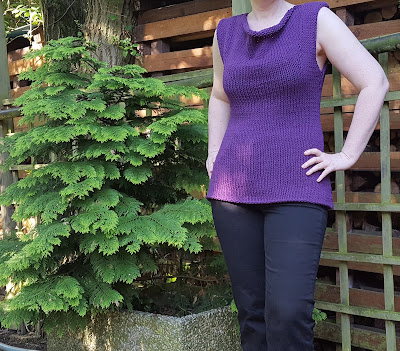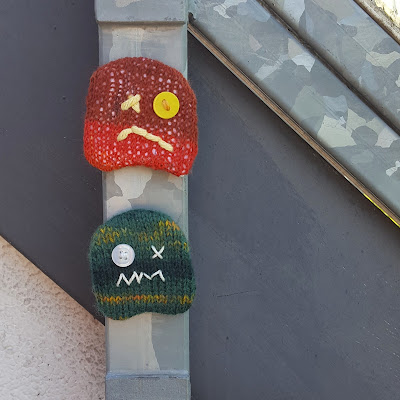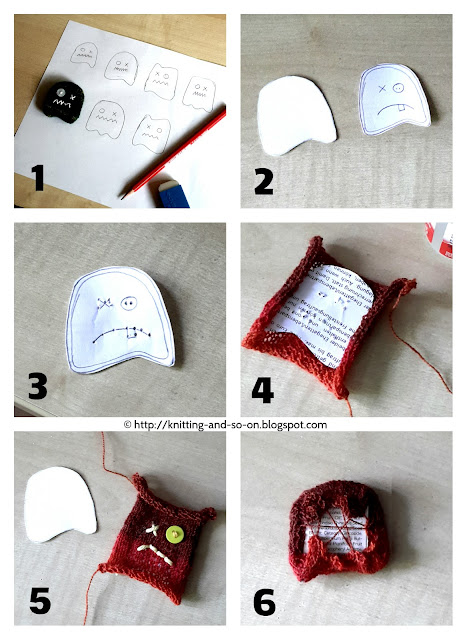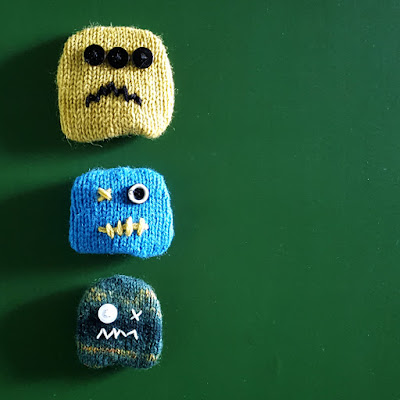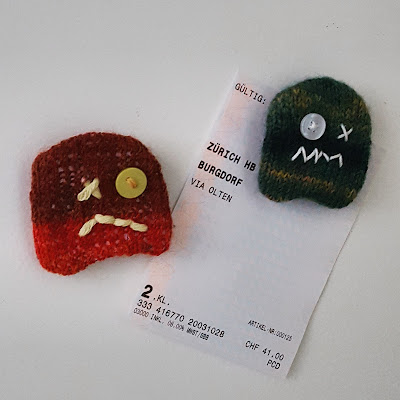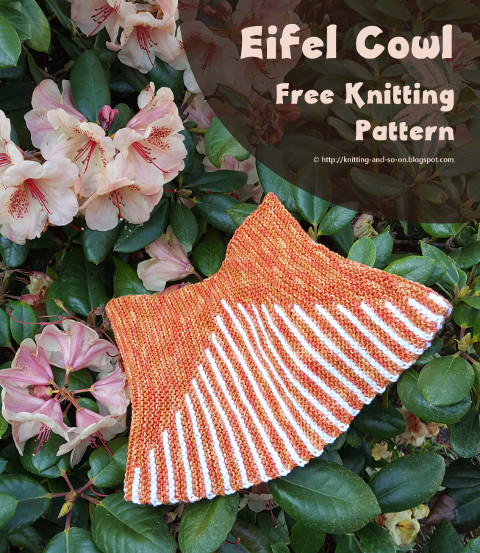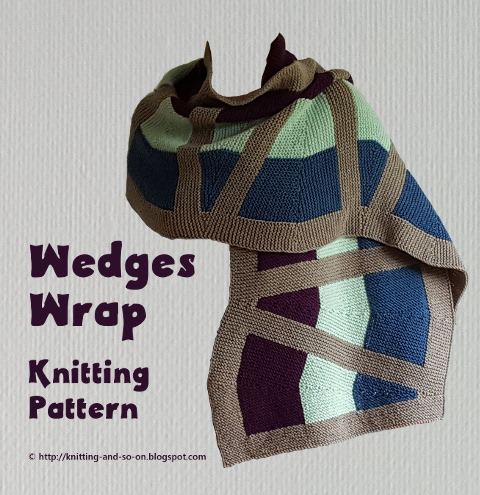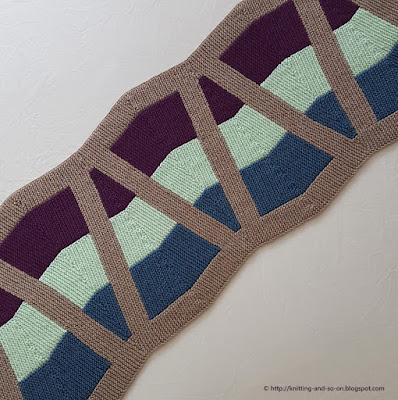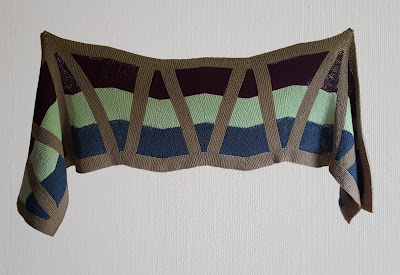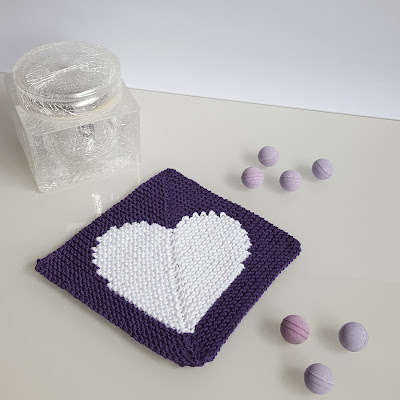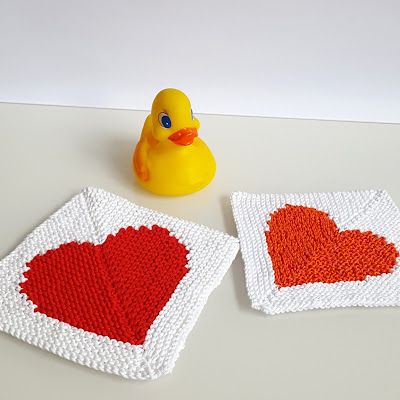So, I tried to create a pattern for myself using one of the great tutorials on the internet (linked below) and knitted the pieces all in stockinette stitch. So, here's a tutorial on how to do something similar for yourself. Since I used bulky yarn, this was a very quick knit for me - it only took me four days to knit the two pieces and - after blocking - one afternoon to sew it and to weave in the ends.
This sleeveless tunic is knitted in plain stockinette stitch. It is shaped to suit your body and has an elegant waterfall neck. It is knitted in two pieces (front and back) from bottom to top.
It is NOT a stitch-by-stitch knitting pattern for various sizes. It is rather a tutorial how to contruct and knit a similar tunic - and of course you don't have to use bulky yarn but can use other yarn weights as well. I will give you my numbers and calculations as an example written in purple.


This work by Knitting and so on is licensed under a Creative Commons Attribution-NonCommercial-ShareAlike 4.0 International License.
Materials
- 300 to 400 grams of bulky weight cotton yarn (for my size I used a little over 300 grams - about 425 meters of yarn)
- 8 mm needles (the yarn label asked for 5.5 - 6 mm needles, but since I wanted the fabric to be very loose I chose bigger needles)
- 2 stitch markers
- a tapestry needle to weave in ends and to sew the pieces together
Useful Techniques and Abbreviations
- How to make a cowl top pattern (for sewing): see this YouTube video by IzzyMEIMsaab.
- Make One Knit-Stitches (here's a video by PurlSoho that shows these stitches)
- mk1l (left-leaning): pick up the bar from front to back and knit it through the back loop
- mk1r (right-leaning): pick up the bar from back to front and knit it through the front loop
- Make One Purl-Stitches (here's a video by KnitPurlHunter that shows these stitches)
- mk1p right-leaning (mk1pl, i.e. right-leaning effect on RS): make one purl stitch by inserting the left-hand needle from the back in the bar between the two stitches and purl through the front of the loop
- mk1p left-leaning (mk1pr, i.e. left-leaning effect on RS): make one purl stitch by inserting the left-hand needle from the back in the bar between the two stitches and purl through the back of the loop
- Mattress stitch to create an invisible seam between two stockinette pieces: see this YouTube video by iknitwithcatfur.
- How to knit shoulder seams: see this YouTube video by knitpurlhunter.
Measuring and Swatching
I created a pattern on paper (any broadsheet newspaper will do) using the method shown in IzziMEIMsaab's video). But it will be OK if you just take the measurements listed below.
Note: For me it's difficult to take measurements from my body - that's why I generally use a top that fits me well to take measurements.
Here's an outline of the pattern with all the necessary measurements (since this was inspired by sewing videos, the measurements are shown on the fold, i.e. half of the piece).
You need to measure:
A = from your hips to your waist
B = from your waist to your bust
C = from your bust to under your arm
D = A + B + C = from your hips to under your arm
E = from the shoulder to under your arms
F = one quarter (1/4) of your hip circumference
G = one quarter (1/4) of your waist circumference
H = one quarter (1/4) of your bust circumference
I = one quarter (1/4) of your underarm circumference
J = shoulder seam
Kback = half of your neck width
Drape your measuring tape from shoulder to shoulder around your neck to see how deep you want your neckline to fall (see IzziMEIMsaab's video at minute 1:44). Then see how many cm this is on your measuring tape. Kfront is half of that measurement.
Knit a swatch! And block it.
Then carefully count your stitches and rows and calculate the numbers of the measurements you've taken.
My swatch gave the following numbers: 10 cm = 10.5 sts in width and 10 cm = 16 rows in height. Then I calculated:
A = 27 cm => 2.7 x 16 = 43.2 => 43 rows
B = 11 cm => 1.1 x 16 = 17,6 => 18 rows
C = 5 cm => 0.5 x 16 = 8 => 8 rows
D = A + B + C => 69 rows
E = 22 cm => 2.2 x 16 = 35,2 => 35 rows
F = 25 cm => 2.5 x 10.5 = 26.25 => 26 sts
G = 19 cm => 1.9 x 10.5 = 19.95 => 20 sts
H = 23 cm => 2.3 x 10.5 = 24.15 => 24 sts
I = 22 cm => 2.2 x 10.5= 23.1 => 23 sts
J = 12 cm => 1.2 x 10.5 = 12.6 => 13 sts
Kback = 9 cm => 0.9 x 10.5 => 9.45 => 10 sts
Kfront = 21 cm => 2.1 x 10.5= 22.05 => 22 sts
Instructions
B = from your waist to your bust
C = from your bust to under your arm
D = A + B + C = from your hips to under your arm
E = from the shoulder to under your arms
F = one quarter (1/4) of your hip circumference
G = one quarter (1/4) of your waist circumference
H = one quarter (1/4) of your bust circumference
I = one quarter (1/4) of your underarm circumference
J = shoulder seam
Kback = half of your neck width
Drape your measuring tape from shoulder to shoulder around your neck to see how deep you want your neckline to fall (see IzziMEIMsaab's video at minute 1:44). Then see how many cm this is on your measuring tape. Kfront is half of that measurement.
Knit a swatch! And block it.
Then carefully count your stitches and rows and calculate the numbers of the measurements you've taken.
My swatch gave the following numbers: 10 cm = 10.5 sts in width and 10 cm = 16 rows in height. Then I calculated:
A = 27 cm => 2.7 x 16 = 43.2 => 43 rows
B = 11 cm => 1.1 x 16 = 17,6 => 18 rows
C = 5 cm => 0.5 x 16 = 8 => 8 rows
D = A + B + C => 69 rows
E = 22 cm => 2.2 x 16 = 35,2 => 35 rows
F = 25 cm => 2.5 x 10.5 = 26.25 => 26 sts
G = 19 cm => 1.9 x 10.5 = 19.95 => 20 sts
H = 23 cm => 2.3 x 10.5 = 24.15 => 24 sts
I = 22 cm => 2.2 x 10.5= 23.1 => 23 sts
J = 12 cm => 1.2 x 10.5 = 12.6 => 13 sts
Kback = 9 cm => 0.9 x 10.5 => 9.45 => 10 sts
Kfront = 21 cm => 2.1 x 10.5= 22.05 => 22 sts
Instructions
Back piece
Hip to Waist
CO twice the stitches you've calculated for F plus 2 edge stitches (in my case 2x26 + 2 = 54).
Then knit in plain stockinette up to your waist while decreasing at the sides:
Normal row (RS): sl1, k to end
Normal row (WS): sl1, p to end
Decrease row (RS): sl1, ssk, k to last 3 sts, k2tog, k1
Decrease row (WS): sl1, p2tog, p to last 3 sts, p2togtbl, p1
Calculate the decreases you need for a shaped waist per side: F-G. (I had to decrease 6 sts per side (F-G => 26-20 = 6) over 43 rows. I only wanted to decrease on RS, so I chose to knit normal rows, and then I knitted one decrease row instead of every 6th normal row.)
Waist to Bust
From the waist up to your bust, you want to increase, i.e. to knit normal rows as well as increasing rows. For this you want to calculate the number of stitches per side that you need to increase (H-G) over the rows you calculated for B. (I had to decrease 4 sts (H-G=24-20 = 4) over 18 rows (B).)
Increase row (RS): sl1, mk1l, k to last 2 sts, mk1r, k1
Increase row (WS): sl1, mk1p, p to last 2 sts, mk1p, p1
Bust to Armhole
From your bust line to the arm hole you'll want to decrease again. Here you need to calculate the number of stitches to decrease per side (I-H) over C rows. The decrease rows are the same as listed above. (I had to decrease only 1 sts (I-H = 24-23=1) per side over 8 rows.)
Armhole to Shoulder
If you're shoulder measurement (J+Kback) is narrower or wider than your underarm measurement (I) you also need to knit increase or decrease rows over the next E rows. In my case I didn't have to decrease (J+Kback-I = 13+10-23=0)).
When you've finished these last rows. Bind off.
The back piece is finished.
Front piece
Hip to Armhole
From the waist up to the armhole the front piece is knitted exactly as your back piece. So knit this exactly as your back piece up to the last row.
During the last row put in two stitchmarkers: look at the stitch number you calculated for your shoulder measurement (J, 13 sts in my case) and put the first stitchmarker J sts away from the beginning of the row, and the second stitch marker J sts away from the end of the row.
Armhole to shoulder
Now you need to calculate the increases per side for the waterfall neckline. This is the difference between Kback and Kfront, i.e. Kfront-Kback (in my case: 22-10=12). These increases have to be distributed evenly over the number of rows you calculated for E (in my case over 36 rows; 36 / 12 = 3, this means I had to increase every 3rd row).
Neck Increase Row (RS): sl1, k to marker, mk1r, k to next marker, mk1l, k to end
Neck Increase Row (WS): sl1, p to marker, mk1pl, p to next marker, mk1pr, p to end
Alternate neck increase rows as calculated with normal (stockinette) rows until you've knitted the rows you calculated for E. Then bind off. Now your front piece is finished, too.
Finishing
I blocked both piece to size and then sewed them at the sides and the shoulders. I used the techniques linked above (mattress stitch & invisible seam).
This post was featured on OuiCrochet's Fiber Tuesday Link Party #115 and at the New Tuesday Pin-spiration Link Party.. Thank you!




